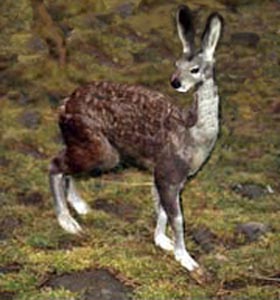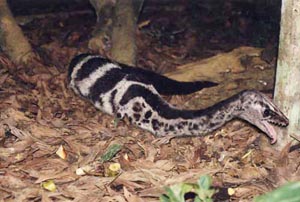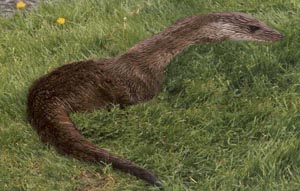Rabbuc are variety of warm-blooded terrestrial herbivore. They resemble deer with the heads of rabbits. A typical adult rabbuc weighs around 120 kg. Rabbuc frequent the grasslands of Anexea, but can be found throughout the continent. Many sub-species exist, each adapted to its particular niche.
Rabbuc show dimorphism between the genders with adult males being 50% larger than adult females on average. Young are live birthed usually as twins in the spring. and reach sexual maturity after one and a half years.
As ground foragers, rabbuc will consume grasses and other leafy plants, as well as the leaves of shrubs, and even the bark of some trees.
Rabbuc typically rely on speed and agility to evade predators, but if pressed may bite, or kick in defence. They also possess bony ridges along the back of the forelegs, which are more pronounced in males and used in sparring over breeding privileges.
Many species of rabbuc have been domesticated successfully, and typically make up about 30-50% of all pastured livestock depending on the nation. Rabbuc are a excellent source of fatty milk, meat, and supple leather.
In the wild rabbuc herds tend to number less than two dozen animals, generally under the control of a dominant male. lone encounters are generally with young males seeking a harem of their own.
COMMON RABBUC
The most often encountered species, and regular domestic variety. The common rabbuc is considered more docile than other species and is kept as a domestic source of meat, milk and leather. They tend to light brown or ginger toned hair.
LONG NECKED RABBUC
This variety of rabbuc has a distinctive elongated neck compared to others. As a browser of low to mid height trees and shrubs, they are often found in more arid regions of scrub land, or savanna. Their light tawny, or grey hair blends easily into the landscape providing some camouflage
MANED RABBUC
This species possesses a coarse, long haired mane similar to a horse. Their hair ranges through darker browns, and blacks.
RABBOX
A giant species of rabbuc, domesticated as beasts of burden and labour. The average adult can reach 2-3 meters in length, 1.5 meters at the shoulder, and mass between 4-700 kg.
SHAGGY RABBUC

Found in colder regions or altitudes, the shaggy rabbuc has a heavy coat of woolly hair. Where they are domesticated they provide a renewable source of textile fibres in addition to the usual meat, milk and leather.
SPINY RABBUC
This species of rabbuc is a dwarf variety rarely larger than 50 kg. They have stiff long whisker-like hairs along their spine and a shaggier than average coat. they are primarily found in foothills, and mountainous regions.
SPOTTED RABBUC
This exclusively plains dwelling species is somewhat smaller than average, and tends to form herds numbering in the hundreds.
WHITE FOOTED RABBUC

This woodland dwelling species is noted for the distinctive white hair on the lower portions of their legs. Their coats tend to rust browns, and have white spots for the first few years.



